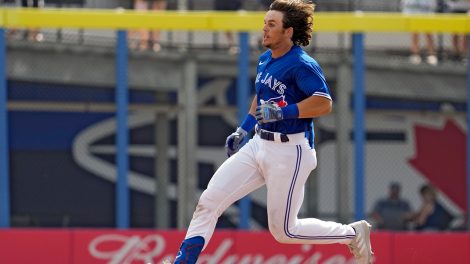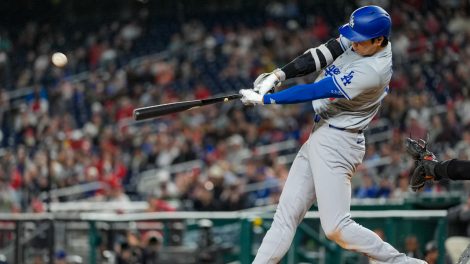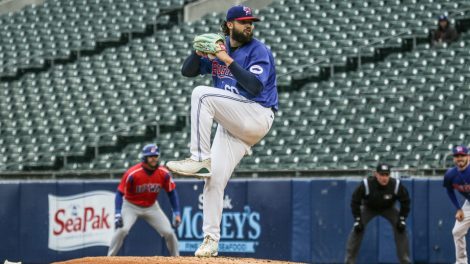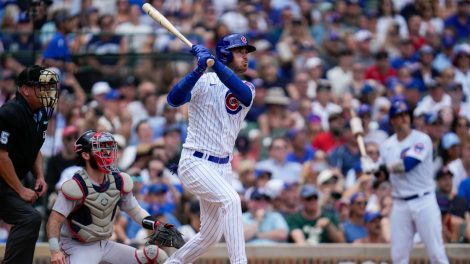Bartolo Colon might be a one-pitch pitcher closing in on his 41st birthday, but the New York Mets believe he can do more than provide a steady supply of innings. The Mets expect Colon’s willingness to attack the strike zone will help the development of the electric arms currently making their way to the big leagues.
Promising young pitchers such as Zack Wheeler, Noah Syndergaard and Rafael Montero may have better stuff than Colon, but they can still learn from his unique approach to pitching.
“He doesn’t mess around,” says Paul DePodesta, the Mets’ VP of player development and amateur scouting. “He throws 85 percent fastballs and throws them in the zone and makes the hitters hit them. More often than not in the last few years and for the bulk of his career they haven’t been able to. It’s a mindset that should only help us with some of our other players.”
In fact it’s already started happening. DePodesta was watching a recent bullpen session of Colon’s with a young pitcher, when they noticed how consistently the right-hander found the strike zone.
“I said ‘he hits the glove, huh?’,” DePodesta recalls. “The player just shook his head and he said ‘every time.’ That’s pretty powerful.”
***
For the first few years of Sandy Alderson’s tenure as general manager, the Mets operated like a small market team while playing in the sport’s biggest market. Burdened by bad contracts for the likes of Jason Bay and Johan Santana, the Mets had to stop spending big until owner Fred Wilpon gained financial certainty by settling for $162 million with the trustee representing Bernie Madoff’s victims.
It meant Alderson’s forays into free agency were decidedly modest. Shaun Marcum was the Mets’ big signing a year ago. Frank Francisco was the big addition the winter before that.
Led by Alderson, DePodesta, J.P. Ricciardi and John Ricco, the Mets focused on building a strong core of prospects instead. It meant trading Carlos Beltran and R.A. Dickey for Wheeler, Syndergaard and Travis d’Arnaud.
Those prospects are a big reason why ESPN ranked the Mets’ farm system sixth-best in baseball this winter. New York has four minor leaguers on Baseball America’s list of the game’s top 100 prospects: Syndergaard (16), d’Arnaud (38), Rafael Montero (68) and Dominic Smith (92). DePodesta and the Mets successfully assembled talent.
But player development matters since it helps the Mets win at Citi Field, not as an end in itself. Now it’s time to spend on big league talent and prioritize the MLB team.
“For the last few years we’ve tried to do an awful lot to build the foundation of the organization and build up the farm system,” DePodesta says. “The entire reason you do that is to win at the MLB level. It’s great to have your system rated highly and it’s great to win minor league championships and all those kind of things, but ultimately what you want is wins at the major league level.”
The Mets signed Colon to a two-year, $20 million contract, part of an off-season plan that included major contracts for Curtis Granderson (four years, $60 million; second round draft selection surrendered) and Chris Young (one-year, $7.25 million).
The Mets aren’t exactly spending like their American League counterparts, but the newfound flexibility allowed Alderson to acquire impact players, veterans who are talented enough to help the Mets improve upon last year’s 74-88 record while easing pressure on prospects as they take on bigger roles.
“It’s very, very difficult to bring up a young player to the major leagues and ask him to hit at the top of the order, or hit in the middle of the order, or be the top guy in your rotation or close games,” DePodesta says. “Any of those key roles and for a number of years we were forced to do that. We didn’t have much of a choice.”
The Mets had to ask Lucas Duda and Ike Davis to be major offensive contributors as soon as they reached the big leagues. They don’t want to have to do it again.
“We think an awful lot of Travis d’Arnaud, but you don’t want to hit him first when he’s a rookie,” DePodesta says. “You want to hit him seventh or sixth, especially in a place like New York, where the spotlight is so bright to begin with.”
***
Even as Matt Harvey continues recovering from Tommy John surgery, the Mets have an enviable selection of young arms that could rival the deep rotations in Washington and Atlanta by next year.
In Wheeler they have a pitcher who posted a 3.42 ERA in 100 innings as a rookie in 2013. Armed with a fastball that sits just shy of 95 m.p.h., he could take another step forward if he can borrow from Colon’s approach and attack the strike zone more consistently.
“It’s never been an issue of stuff with Zack,” DePodesta says. “The command’s always been fine, but it hasn’t been (Greg) Maddux-esque or Colon-esque and I don’t expect it to be, I don’t think any of us do.”
Harvey debuted midway through the 2012 season, Wheeler debuted midway through the 2013 season and Syndergaard and Montero appear to be on track to follow a similar timeline and debut this summer. While the Mets say there’s no pre-determined timetable for their pitching prospects, they’re openly optimistic about Syndergaard, a pitcher who has a 97 m.p.h. fastball and what manager Terry Collins recently described as a ‘hook from hell.’
“He has a chance to make an impact on our big league club and getting to the point where maybe that’s sooner rather than later,” DePodesta says.
Mets scouts believe Syndergaard offers a rare and promising blend of size, youth, stuff and command.
“That combination you just don’t see together very often,” DePodesta says. “You may see two or you may see three, but to get all four of them. To have a 6-foot-6 19-year-old throwing that hard and pounding the zone? It’s really unusual. Needless to say we’re happy to have him and we certainly think he can be a big part of our future.”
The one tasked with catching these arms is d’Arnaud, who came over with Syndergaard from the Toronto Blue Jays following the 2012 season. Slated to become the team’s starting catcher, d’Arnaud projects as an above -average defensive catcher who can contribute with the bat.
“It’s difficult to find those guys at catcher, shortstop and centre. Guys who can play those premium defensive positions, play them well — above average — and also contribute on the offensive side of the ball,” DePodesta says.
So are there any concerns about relying so heavily on a catcher who has appeared in just 31 big league games? The Mets view the 25-year-old as an energetic player capable of leading at a young age and improving as he goes.
“By the time the pitchers get there, he’s going to be quite experienced and he’ll know the league very well,” DePodesta says. “The good news is he’s a good defender. He’s an above-average defender even today and while he certainly doesn’t have the experience that a (Yadier) Molina has, the plus defence does help.”
Combine d’Arnaud, Wheeler, Syndergaard and Montero with newcomers such as Colon and Granderson and there are suddenly lots of reasons to watch the Mets try to post a winning record for the first time since 2008.
Colon probably won’t be around by the time New York’s young pitchers reach their prime, but if the Mets’ plan works, he will have helped the franchise develop from a cash-strapped afterthought to a winner built around a dynamic, young rotation.









